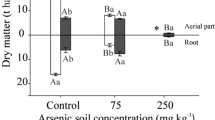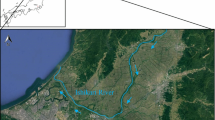Abstract
Mechanisms of natural attenuation of arsenic (As) by wetland plants may be classified by plant uptake and adsorption and/or co-precipitation by iron (oxy)hydroxide formed on the root surface of plants or in rhizosediment. A natural Cattail (Typha spp.) wetland impacted by tailings containing high levels of As from the Myungbong abandoned Au Mine, South Korea was selected, and the practical capability of this wetland to attenuate As was evaluated. The As concentrations in the plant tissues from the study wetland were several-fold higher than those from control wetland. SEM-EDX analyses demonstrated that iron plaques exist on the rhizome surface. Moreover, relatively high As contents bonded with hydrous iron oxides were found in the rhizosediments rather than in the bulk sediments. It was revealed through the leaching and sequential extraction analyses that As existed as more stable forms in the wetland sediment compared with adjacent paddy soil, which is also contaminated with As due to input of mine tailings. The As concentration ratios of extracted solution to sediment/soil represented that the wetland sediment showed significant lower values (10-fold) rather than the paddy soil with indicating high As stability. Also, As in the wetland sediment was predominantly bonded with residual phases on the basis of results from sequential extraction analysis. From these results, it is concluded that transformation of As contaminated agricultural field to wetland environment may be helpful for natural attenuation until active remediation action.





Similar content being viewed by others
References
Ahn, J. S., Kim, J. Y., Chon, C. M., & Moon, H. S. (2003). Mineralogical and chemical characterization of arsenic solid phases in weathered mine tailings and their leaching potential. Economic and Environmental Geology, 36, 27–38.
Almeida, C. M. R., Mucha, A. P., & Vasconcelos, M. T. S. D. (2006). Comparison of the role of the sea club-rush Scirpus maritimus and the sea rush Juncus maritimus in terms of concentration, speciation and bioaccumulation of metals in the estuarine sediment. Environmental Pollution, 142, 151–159.
Armstrong, W. (1964). Oxygen diffusion from the roots of some British bog plants. Nature, 204, 801–802.
Batty, L. C., Baker, A. J. M., Wheeler, B. D., & Curtis, C. D. (2000). The effect of pH and plaque on the uptake of Cu and Mn in Phragmites australis (Cav.) Trin ex. Steudel. Annals of Botany, 86, 647–653.
Belzile, N., & Tessier, A. (1990). Interactions between arsenic and iron oxyhydroxides in lacustrine sediments. Geochimica et Cosmochimica Acta, 54, 103–109.
Bhattacharya, P., Classon, M., Bundschuh, J., Sracek, O., Fagerberg, J., Jacks, G., et al. (2006). Distribution and mobility of arsenic in the Rı′o Dulce alluvial aquifers in Santiago del Estero Province, Argentina. Science of the Total Environment, 358, 97–120.
Cao, X. D., & Ma, L. Q. (2004). Effects of compost and phosphate on plant arsenic accumulation from soils near pressure-treated wood. Environmental Pollution, 132, 435–442.
Chen, C. C., Dixon, J. B., & Turner, F. T. (1980). Iron coatings on rice roots: Morphology and models of development. Soil Science Society of America Journal, 44, 1113–1119.
Deng, D., Wu, S. C., Wu, F. Y., Deng, H., & Wong, M. H. (2010). Effects of root anatomy and Fe plaque on arsenic uptake by rice seedlings grown in solution culture. Environmental Pollution, 158, 2589–2595.
Doyle, M. O., & Otte, M. L. (1997). Organizm-induced accumulation of iron, zinc and arsenic in wetland soils. Environmental Pollution, 96, 1–11.
Fitzgerald, E. J., Caffrey, J. M., Nesaratnam, S. T., & McLoughlin, P. (2003). Copper and lead concentrations in salt mash plants on the Suir Estuary, Ireland. Environmental Pollution, 123, 67–74.
Ford, R. G., Wilkin, R. T., & Hernandez, G. (2006). Arsenic cycling within the water column of a small lake receiving contaminated ground-water discharge. Chemical Geology, 228, 137–155.
Foster, S., Maher, W., Taylor, A., Krikowa, F., & Telford, K. (2005). Distribution and speciation of arsenic in temperate marine saltmarsh ecosystems. Environmental Chemistry, 2, 177–189.
Gebel, T. (1997). Arsenic and antimony: Comparative approach on mechanistic toxicology. Chemico-Biological Interactions, 107, 131–144.
Hansel, C. M., & Fendorf, S. (2001). Characterization of Fe plaque and associated metals on the roots of mine-waste impacted aquatic plants. Environmental Science and Technology, 35, 3863–3868.
Hansel, C. M., La Force, M. J., Fendorf, S., & Sutton, S. (2002). Spatial and temporal association of As and Fe species on aquatic plant roots. Environmental Science and Technology, 36, 1988–1994.
Jacobs, L. W., Syers, J. K., & Keeney, D. R. (1970). Arsenic sorption by soils. Soil Science Society of America Proceedings, 34, 750–754.
Jain, A., Raven, K. P., & Loeppet, R. H. (1999). Arsenite and arsenate adsorption on ferrihydrite: Surface charge reduction and net OH− release stoichiometry. Environmental Science and Technology, 33, 1179–1184.
Kapaj, S., Peterson, H., Liber, K., & Bhattacharya, P. (2006). Human health effects from chronic arsenic poisoning—A review. Journal of Environmental Science and Health Part A, 41(10), 2399–2428.
Karathanasis, A. D., & Johnson, C. M. (2003). Metal removal by three aquatic plants in an acid mine drainage wetland. Mine Water and the Environment, 22, 22–30.
Kelly, J., Champagne, P., & Minchel, F. (2007). Assessment of metal attenuation in a natural wetland system impacted by alkaline min tailings, cobalt, Ontario, Canada. Mine Water and the Environment, 26, 181–190.
Kim, J. Y., Davis, A. P., & Kim, K. W. (2003). Stabilization of available arsenic in highly contaminated mine tailings using iron. Environmental Science and Technology, 37, 189–195.
Ko, I., Ahn, J. S., Park, Y. S., & Kim, K. W. (2003). Arsenic contamination of soils and sediments from tailings in the vicinity of Myungbong Au mine, Korea. Chemical Speciation and Bioavailability, 15, 67–74.
La Force, M. J., Hansel, C. M., & Fendorf, S. (2000). Arsenic speciation, seasonal transformations, and co-distribution with iron in a mine waste-influenced Palustrine emergent wetland. Environmental Science and Technology, 34, 3937–3943.
Laura, H., & Dave, C. (2008). Processes of attenuation of dissolved arsenic downstream from historic gold mine sites, New Zealand. Science of the Total Environment, 405, 286–300.
Le, X. C., Yalcin, S., & Ma, M. (2000). Speciation of submicrogram per liter levels of arsenic in water: On-site species separation integrated with sample collection. Environmental Science and Technology, 34, 2342–2347.
Lee, S. W., Lee, B. T., Kim, J. Y., Kim, K. W., & Lee, J. S. (2006). Human risk assessment for heavy metals and As contamination in the abandoned metal mine areas, Korea. Environmental Monitoring and Assessment, 119, 233–244.
Lee, J. U., Lee, S. W., Kim, K. W., & Yoon, C. H. (2005). The effects of different carbon sources on microbial mediation of arsenic in arsenic-contaminated sediment. Environmental Geochemistry and Health, 27, 159–168.
Liu, W. J., Zhu, Y. G., Smith, F. A., & Smith, S. E. (2004). Do phosphorus nutrition and iron plaque alter arsenate (As) uptake by rice seedlings in hydroponic culture? New Phytologist, 162, 481–488.
Loebenstein, J. R. (1993). Arsenic: Supply, demand and the environment. In U.S. Environmental Protection Agency (Ed.), Mercury and arsenic wastes: Removal, recovery, treatment and disposal (pp. 67–71). New Jersey: Noyes Data Corporation.
Majzlan, J., Navrotsky, A., & Schwertmann, U. (2004). Thermodynamics of iron oxides: Part III. Enthalpies of formation and stability of ferrihydrite (~Fe(OH)3), schwertmannite (~FeO(OH)3/4(SO4)1/8), and e-Fe2O3. Geochimica et Cosmochimica Acta, 68, 1049–1059.
Mei, X. Q., Ye, Z. H., & Wong, M. H. (2009). The relationship of root porosity and radial oxygen loss on arsenic tolerance and uptake in rice grains and straw. Environmental Pollution, 157, 2550–2557.
Mitsch, W. J., & Gosselink, J. G. (2007). Wetlands (4th ed.). New Jersey: Wiley.
Nriagu, J. O. (1994). Arsenic in the environment. Part I: Cycling and characterization. New York: Wiley.
Otte, M. L., Bestebroer, S. J., Van der Linden, J. M., Rozema, J., & Broekman, R. A. (1991). A survey of zinc, copper and cadmium concentrations in salt marsh plants along the Dutch coast. Environmental Pollution, 72, 175–189.
Otte, M. L., Haarsma, M. S., Broekman, R. A., & Rozema, J. (1993). Relation between heavy metal concentrations in salt-marsh plants and soil. Environmental Pollution, 82, 13–22.
Otte, M. L., Rozema, J., Beek, M. A., Kater, B. J., & Broekman, R. A. (1990). Uptake of arsenic by estuarine plants and interactions with phosphate, in the field (Rhine estuary) and under outdoor experimental conditions. Science of the Total Environment, 98, 839–854.
Pierce, M. L., & Moore, C. B. (1982). Adsorption of arsenite and arsenate on amorphous iron hydroxide. Water Research, 16, 1247–1253.
Raven, K. P., Jain, A., & Loeppet, R. H. (1998). Arsenite and arsenate adsorption on ferrihydrite: Kinetics, equilibrium, and adsorption envelopes. Environmental Science and Technology, 32, 344–349.
Reddy, K. R., D’Angelo, E. M., & DeBusk, T. A. (1990). Oxygen transport through aquatic macrophytes: The role in wastewater treatment. Journal of Environmental Quality, 19, 261–267.
Singh, A. K. (2006). Chemistry of arsenic in groundwater of Ganges-Brahmaputra river basin. Current Science, 91, 599–606.
Smedley, P. L. (2005). Arsenic occurrence in groundwater in South and East Asia—Scale, causes and mitigation. In Towards a more effective operational response: arsenic contamination of groundwater in South and East Asian countries. (Vol. 2), Technical Report, The World Bank Report No. 31303.
Smedley, P. L., & Kinniburgh, D. G. (2002). A review of the source, behaviour and distribution of arsenic in natural waters. Applied Geochemistry, 17, 517–568.
Smith, A. H., Biggs, M. L., Moore, L., Haque, R., Steinmaus, C., Chung, J., et al. (1999). Cancer risks from arsenic in drinking water: Implications for drinking water standards. In W. R. Chappell, C. O. Abernathy, & R. L. Calderon (Eds.), Arsenic exposure health effects (pp. 191–200). UK: Elsevier.
Tandukar, N., Bhattacharya, P., Neku, A., & Mukherjee, A. B. (2006). Extent and severity of arsenic poisoning in Nepal. In Groundwater arsenic contamination in India: Extent and severity. In R. Naidu, G. Owens, E. Smith, & P. Nadebaum (Eds.), Managing arsenic in the environment: From soil to human health (pp. 595–604). Australia: CSIRO Publishing.
Taylor, G. J., Crowder, A. A., & Rodden, R. (1984). Formation and morphology of an iron plaque on the roots of Typha Latifolia L. grown in solution culture. American Journal of Botany, 71, 666–675.
Ure, A. M. (1995). Method of analysis for heavy metals in soils. In B. J. Alloway (Ed.), Heavy metal in soils (2nd ed., pp. 55–68). Glasgow: Chapman & Hall.
Wenzel, W. W., Kirchbaumer, N., Prohaska, T., Stingeder, G., Lombi, E., & Adriano, D. C. (2001). Arsenic fractionation in soils using an improved sequential extraction procedure. Analytica Chimica Acta, 436, 309–323.
Wilkie, J. A., & Hering, J. G. (1996). Adsorption of arsenic onto hydrous ferric oxide: Effects of adsorbate/adsorbent ratios and co-occurring solutes. Colloids and Surfaces A: Physicochemical and Engineering Aspects, 107, 97–110.
Xu, S., Leri, A. C., Myneni, S. C., & Jaffe, P. R. (2004). Uptake of bromide by two wetland plants (Typha latifolia L. and Phragmites australis (Cav.) Trin. ex Steud). Environmental Science and Technology, 38, 5642–5648.
Acknowledgments
This research was supported by Korea Science & Engineering Foundation (KOSEF) through the Joint Research Program (Grant No. F01-2008-000-10118-0). The field sampling provided by Jin-Soo Chang, Ki-Rak Kim, and Dae-Sung Song is gratefully acknowledged.
Author information
Authors and Affiliations
Corresponding author
Rights and permissions
About this article
Cite this article
An, J., Kim, JY., Kim, KW. et al. Natural attenuation of arsenic in the wetland system around abandoned mining area. Environ Geochem Health 33 (Suppl 1), 71–80 (2011). https://doi.org/10.1007/s10653-010-9361-3
Received:
Accepted:
Published:
Issue Date:
DOI: https://doi.org/10.1007/s10653-010-9361-3




